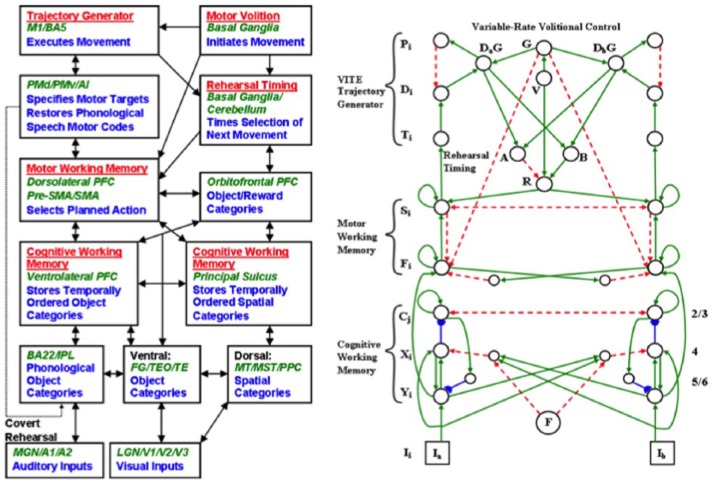Figure 10.
LIST PARSE model. (Left panel) The brain processes that are modelled by LIST PARSE are written in red and underlined. These processes are a Cognitive Working Memory, assumed to be in VLPFC; a Motor Working Memory, assumed to be in DLPFC; a VITE, or Vector Integration To Endpoint, Trajectory Generator, assumed to be in motor cortex; Motor Volition, assumed to be in the basal ganglia substantia nigra pars reticulata, or SNr; and Rehearsal Timing, assumed to be in the basal ganglia and cerebellum. (Right panel) The Cognitive Working Memory network is assumed to be within the deeper layers 4–6 of VLPFC, and the corresponding list chunking network is assumed to be within the superficial layers 2/3 of VLPFC. Green solid arrows are excitatory, red dashed arrows are inhibitory, and blue lines ending in hemidiscs are adaptive. Only 1-item chunks (Ci) and their feedback connections within a single Cognitive Working Memory channel are shown, whereas the model simulates chunks corresponding to words of variable lengths in layer 2/3. Learned positive feedback signals from layer 2/3 to layer 5/6 of the cognitive working memory are broadly distributed from each list chunk across the working memory so that an active chunk can reinstate the activity pattern that caused it into working memory. Also, only the excitatory projections from Cognitive Working Memory to the Motor Working Memory (Yi→Fi) are shown. Several volitional gain control signals determine model dynamics. For example, the gain control signal F determines whether or not a sequence will be stored within the Cognitive Working Memory. The volitional signals V and G control variable-rate performance of the stored sequence. In particular, a rehearsal wave R is influenced by the volitional signal V when the network begins to recall items and by the deceleration signal (B – A) that allows another rehearsal burst to occur when a previously activated movement trajectory is almost completed. The text described more completely how the deceleration signal is computed.
Source: Adapted with permission from Grossberg and Pearson (2008).

